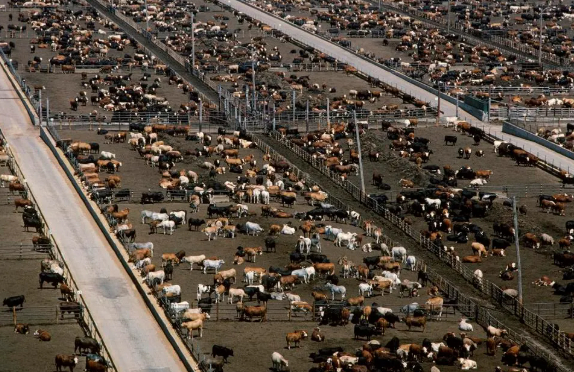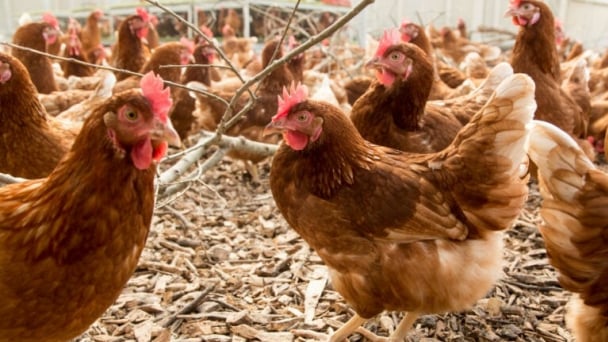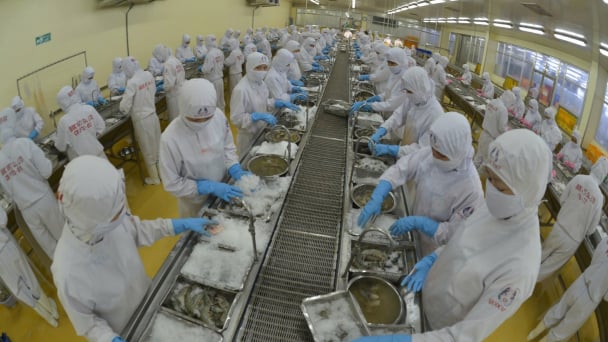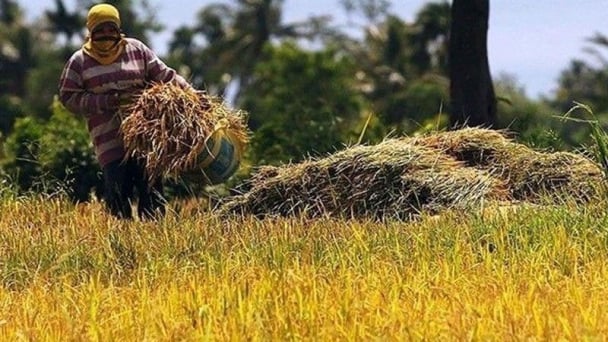April 15, 2025 | 13:28 GMT +7
April 15, 2025 | 13:28 GMT +7
Hotline: 0913.378.918
April 15, 2025 | 13:28 GMT +7
Hotline: 0913.378.918

Agriculture - High view of a large beef feedlot / near Lubbock, Texas, USA.
Now imagine a feedlot with thousands of cows trampling in the dirt, the smell of rotten eggs wafting from a manure lagoon, and a couple dead cow carcasses waiting to be hauled away. Would you prefer to live next to a pastoral farm practicing regenerative agriculture or a factory farm housing thousands of cows? For most of us, the answer is easy. But the answer is not so easy if the question is: Which system–regenerative agriculture or factory farming–has the greatest potential to reduce farming’s climate footprint?
By way of background, agriculture is responsible for about 30% of total greenhouse gas emissions globally and 11% of climate emissions in the U.S. Beef production alone accounts for about 6% of total global emissions, compared to about 2.5% for flying. As other sectors like energy and transportation make the green transition, agriculture emissions will occupy an even bigger slice of the pie. And farming will receive more scrutiny from advocates and activists bent on avoiding the worst outcomes of climate change. Given agriculture’s outsized footprint, might regenerative agriculture help solve agriculture’s climate woes?
Regenerative agriculture aims to restore the health of soils through farming practices based on natural processes. For example, when farmers plant alfalfa or other crops that increase nitrogen in the soil, they can lower their use of synthetic fertilizers. When farmers stop plowing soils each year, they can reduce soil erosion. When livestock graze in pastures, air pollution caused by huge heaps of manure and dust from thousands of cattle trampling dirt in feedlots is avoided.
Perhaps it is not surprising that regenerative agriculture is gaining popularity as a response to the ills of factory farming. Throughout the ages agriculture has evolved in response to new concerns. The Green Revolution was launched in the 1960s to eliminate widespread hunger and malnutrition in low-income countries. Its breeding programs increased the yield of rice, wheat, and other major crops by 44% between 1965 and 2010. On the down side, intensive farming practices to feed a growing human population threatened the health of the very soils that grow our food. Soils have been ravaged by erosion, contaminated by herbicides and fertilizers, compacted by cows and heavy farm equipment, and depleted of organic material and nutrients. On a global scale the annual loss of 75 billion tons of soil costs the world about US$400 billion per year. Over the period 2015-2040, land degradation could reduce global food productivity by 12%, leading to a 30% increase in food prices–a major concern given recent food price inflation.
Regenerative agriculture promises a more sustainable food production system that restores agricultural soils and rural livelihoods, grows healthier food, and is resilient to increasingly severe disturbances like floods, droughts and extreme temperatures. Conservation programs in the U.S. Farm Bill support the growing number of farmers who want to adopt these practices. McKinsey calculates that regenerative agriculture could provide up to $80 billion in cash flows for U.S. corn farmers over ten years.
Despite the many benefits of regenerative agriculture, questions about its potential to reduce greenhouse gases linger. Which regenerative agriculture practices are most effective in taking greenhouse gases out of the atmosphere, storing carbon in soils, and reducing emissions? Will these practices be able to feed a growing global population without increasing greenhouse gas emissions? By way of answering these questions, let’s explore some regenerative agriculture practices and their ability to draw down CO2 in the atmosphere.
No-till refers to farming without plowing the soil. A study using a global dataset of 178 experimental sites concluded that soils that aren’t plowed can store more carbon in some, but not all, soil types and climatic conditions. In other words, given the right conditions, no-till can contribute to reducing greenhouse gases.
Studies show that cover crops–or crops like rye planted to enhance the health of soils rather than to harvest–have greater potential than no-till agriculture to capture carbon from the atmosphere. But again results are highly variable, depending on factors such as how long the cover crops are allowed to grow and the types of soils they are growing on. In a review of 40 studies, cover crops increased soil carbon by an average of 12%, whereas in a different review of 35 studies, cover crops did not increase soil carbon in 71% of the comparisons of sites with no cover crops.
Agroforestry refers to planting trees and annual crops together. A review of 78 studies from 30 countries found that soil carbon was generally higher in farms with both crops and trees than in farms with only crops, but lower than in forests. The gain in soil carbon under agroforestry was substantial in tropical and arid regions, but not in temperate areas like the northeast U.S. Again results were highly variable depending on previous land uses, climate, and initial soil carbon.
Because beef and dairy are responsible for 14%–18% of global climate emissions, we need to consider all approaches to reducing their climate impact. In lands too dry or otherwise unsuitable for raising crops, allowing livestock to graze freely is an important means of producing food. In regenerative agriculture, cows are allowed to graze in pastures rather than being fed grain in feedlots. In some instances, manure on pastures can promote plant growth, and because plants absorb carbon dioxide, help mitigate some of livestock’s outsized emissions.
But, similar to results from studies of crops grown using no-till and other regenerative practices, the actual emissions from pasture-raised and feedlot beef vary widely, depending on things like feed, soils, climate, and how long the animal is allowed to live before slaughter. A review of 32 cattle and dairy studies found that because consumers pay a premium for grass-fed beef, the carbon emissions per dollar of profit are lower for grass-fed compared to cheaper feedlot beef. But a study of 100 cattle operations in 16 countries that used weight of meat produced rather than profit revealed that, on average, pasture-raised operations emit more carbon per pound of meat than feedlot-raised cattle. I asked Cornell University* climate scientist Dominic Woolf what he thinks of comparing beef emissions using monetary profit instead of pounds of meat. He responded: “It is well known that high emissions can be profitable, but the real question is whether we as a society should be encouraging such practices. This goes against the reduction in emissions needed to slow climate change.”
How do we explain the result that despite their acrid odor, manure runoff into streams, and often inhumane treatment of animals, feedlot operations are less harmful for the climate per pound of beef than pasture systems? For one, enteric emissions–those methane-laden cow burps–happen across all cattle production systems but may be even higher in grazed cattle due to their fibrous diet. Second, the ability of soils to absorb carbon varies widely in different pastures, but in life-cycle assessments, does not compensate for the cow’s methane emissions and larger land area needed for grazing versus feedlots.
Perhaps most important is the “carbon opportunity cost”–the potential reductions in greenhouse gases if instead of being used for cow pasture, the same land were used to grow forests, restore native ecosystems, or other practices that store larger amounts of greenhouse gases. Another way to think about this is that a pasture-raised cow lives longer but doesn’t grow as large as a cow living in a feedlot. This means that more cows and more land are needed to feed the world’s hunger for meat. Put simply, feedlots produce more meat on less land than do pastures. By being more productive, factory farming spares land for forests and other land uses that store carbon.
The World Resources Institute (WRI) explains the importance of factoring in carbon opportunity costs--or the amount of land that is not converted to agriculture when existing farms produce high quantities of food.
All this has led author and environmentalist George Monbiot to pronounce organic, pasture-fed beef and lamb as our most damaging farm products!
I posed this question to Professor Woolf. He had two big picture responses.
Although the ability of regenerative practices to reduce greenhouse gases varies radically across different landscapes, the good news is that a lot of this variability can be explained and predicted. If we implement the right practices in the right places, regenerative agriculture can reduce greenhouse gases.
The bad news is that even if farmers across the globe implement the practices most likely to reduce greenhouse gases while maintaining productivity, the overall impact will only be a small fraction of what is needed to reach our climate goals. Using complex models, Woolf and his colleagues calculated that regenerative agriculture can bring down greenhouse gases by an average of 0.5 gigatons of CO2-e/year. (CO2-e is a measure that standardizes emissions across gases with higher warming potential, such as methane and nitrous oxide.) But this figure doesn’t take into account the possibility of smaller yields shown for some regenerative agricultural practices. Using only practices that increase or maintain yields (and thus spare other land from being converted to agriculture), only 0.13 GT CO2-e per year, or 0.2% of current global emissions, will be avoided through adopting regenerative agriculture practices globally.
There is lots to like about regenerative agriculture–it is more resilient to extreme weather, reduces soil erosion and pollution, and creates desirable landscapes and neighbors. But regenerative agriculture as a comprehensive climate solution for farm emissions is not backed up by the latest science. At the same time, we do need to think about how we can feed the world’s population in a way that reduces greenhouse gases and avoids factory farming’s rampant rates of soil erosion and soil and water pollution.
There are no easy answers. But for now, let’s embrace regenerative agriculture for the right reasons–its potential to restore healthy soils and create beautiful landscapes that anyone would want to live next to. But not for its ability as a one-stop solution to rapidly reduce climate emissions.
forbes

(VAN) After the merger, key leadership personnel of the provinces must consult with the General Secretary, key leaders, and the Standing Secretariat.

(VAN) The latest Business Benchmark on Farm Animal Welfare (BBFAW) reveals steady progress on farm animal welfare across the global food industry.

(VAN) Green credit is a financial policy that effectively supports environmentally friendly projects and activities today.
/2025/04/09/1049-2-165919_630.jpg)
(VAN) With a revenue of less than VND 30 billion/year, packaging producers are exempted from EPR liability under Decree No. 05/2025 newly issued.

(VAN) Ministry of Agriculture and Environment has issued an Action Plan for sector's development in the coming period, aiming for a growth rate of 4% or higher and an export turnover of USD 65 billion.

(VAN) The 177th Session of the FAO Council opened on Monday at the Organization’s headquarters in Rome.

(VAN) In a statement, the Federation of Free Farmers (FFF) said the government must not be complacent over the reciprocal tariffs even if the Philippines will be slapped with the second lowest rate among US trade partners.